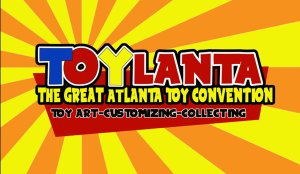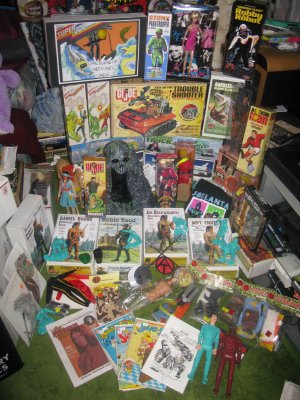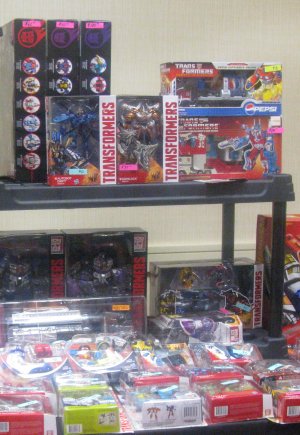The Old Toy Collector
March 17, 2017 by Rudy PanucciSince your PopCulteer is still heavily in toy mode after returning from ToyLanta and then spending the rest of the week neck-deep in video (coming soon, I promise), today I’m going to write about some of the characteristics of collectible toys and how they relate to aging.
One of the things that has me thinking about this is the name change to “ToyLanta” from “JoeLanta and The Great Atlanta Toy Convention.”
The discussions I had with my friends at the show mainly centered around the given fact that collectors of the original GI Joe are an “aging fanbase.”
Of course, any fanbase of anything is aging, with the only exception to that being those that are already dead. In this case, “aging” is a bit of a euphemism for “old, and possibly not at all well.” This is all part of the circle of life of collectible toys. People who love a toy as a child, and retain that love and possibly turn it into an obsession as an adult, find that…you can’t take it with you.
 The “sweet spot” for a toy to have a nostalgic collector’s revival is 25 to 40 years after the time it was actively marketed. People who grow up with a certain toy tend to lose interest in their adolescence, then as they approach middle age, rekindle their fondness for the toy, and begin to seek it out now that they are able to afford it.
The “sweet spot” for a toy to have a nostalgic collector’s revival is 25 to 40 years after the time it was actively marketed. People who grow up with a certain toy tend to lose interest in their adolescence, then as they approach middle age, rekindle their fondness for the toy, and begin to seek it out now that they are able to afford it.
This is a rough but reliable generalization. Some people love toys that came before or after their prime toy-buying years, and some people collect like mad even if they can’t afford it. So we’re talking in non-universal stereotypes here, but they do tend to trend true.
In the case of GI Joe, the toy was actively marketed from 1964 to 1976. It’s peak years of collectibility were 1999 to 2004. There was plenty of collecting of GI Joe before and after that, but it roughly holds true. While there is still a large and loyal following (largely due to the 1990s revival of the 12″ GI Joe), other toy lines are being more avidly sought out by younger collectors.
By “younger,” I mean guys in their thirties and forties, instead of guys in their fifties and sixties. JoeLanta, which remains the core of ToyLanta, has a unique family atmosphere, and part of that has become the annual counting of daily pills (I think I won that one this year), recounting of surgeries and showing of photos of grandchildren.
 Meanwhile, the folks who are the prime age for collecting right now are the guys who grew up with Star Wars, He Man (seen right), the Real American Hero GI Joes and Transformers.
Meanwhile, the folks who are the prime age for collecting right now are the guys who grew up with Star Wars, He Man (seen right), the Real American Hero GI Joes and Transformers.
Since JoeLanta is a fundraiser for the Cody Lane Memorial Toy and Diorama Museum, it makes sense to welcome all collectors to join in on the fun and become part of the ‘Lanta family.
This year BotLanta manifested itself as a new and vital part of ToyLanta. Next year more toy lines may play a bigger part.
JoeLanta will remain the core of the ToyLanta Great Atlanta Toy Convention. The show was spawned from local 12″ GI Joe collectors in the Atlanta area, somewhat frustrated by the shifting focus of the Official GI Joe Club as they began to cater more to collectors of the RAH Joes, and there are no plans to abandon the incredible dioramas and exclusive figures that have become hallmarks of the show.
 But there’s room for everyone. I even saw a My Little Pony dealer this year. One of the most enjoyable panels (and that’s saying a lot because all of them were great this year) was the Phantom Troublemaker and his Needless Things Podcast devoted to telling Toy Stories.
But there’s room for everyone. I even saw a My Little Pony dealer this year. One of the most enjoyable panels (and that’s saying a lot because all of them were great this year) was the Phantom Troublemaker and his Needless Things Podcast devoted to telling Toy Stories.
This panel consisted of five guys, all of them from a younger generation than the typical JoeLantian, telling stories that crossed generational lines and cracked everybody up.
That’s why the name change to “ToyLanta” is so timely. In a country as divided as ours, people of different races, religions, generations and vastly different political philosophies came together, united by their love of toys.
I didn’t hear of anyone getting into any unpleasant political arguments, and frankly, I needed a weekend like that. I can argue politics any time I want on Facebook (often with the same guys I was hugging last weekend). There was no need to let that get in the way of playing with toys.
 Getting back to the whole aging point. The cycles dictate which toys have a chance to become “hot” again. A lot of this has to do with more than just how long ago they were made. A toy has to be inherently cool. It has to have been well-known by kids. It had to be popular enough to have been played with heavily. And it has to have had a healthy lifespan.
Getting back to the whole aging point. The cycles dictate which toys have a chance to become “hot” again. A lot of this has to do with more than just how long ago they were made. A toy has to be inherently cool. It has to have been well-known by kids. It had to be popular enough to have been played with heavily. And it has to have had a healthy lifespan.
Over the last thirty years, I’ve watched as the toys of my youth, GI Joe, Johnny West, Captain Action, Major Matt Mason–the cool stuff, have gone from unwanted and forgotten to highly collectible to less-sought-after-but-still-valuable.
MEGO seems to be nearing the end of its most collectible phase, as the folks who grew up with those toys complete their collections or lose interest. The most actively-collected toys at the moment are the toys of the 1980s. They are in the “sweet spot.”
 There is a side issue here. Every generation thinks that they had the best toys in the world, and that the toys made before and after they were kids suck in comparison. Arguments can be made to support each generation’s claims, and they often are, so we won’t go into that here.
There is a side issue here. Every generation thinks that they had the best toys in the world, and that the toys made before and after they were kids suck in comparison. Arguments can be made to support each generation’s claims, and they often are, so we won’t go into that here.
The point is that toy collecting makes people happy and it doesn’t harm anyone. That makes it one of the best things in the world. There are people in this world who think that toy collecting is a trivial waste of time. It must be very sad to be so screwed up and bitter that you would deny people a harmless pleasure that brings them great joy.
We’re not getting any younger, but there’s no law that says we can’t act like we are.

That’s the PopCulteer this week. I’m posting like crazy, so keep checking back.

 Subscribe to PopCult
Subscribe to PopCult
